![]()
![]()
![]()
Use LEFT and RIGHT arrow keys to navigate between flashcards;
Use UP and DOWN arrow keys to flip the card;
H to show hint;
A reads text to speech;
195 Cards in this Set
- Front
- Back
|
State the 4 key points of Cell Theory |
A cell is the basic structural and functional unit of living organisms.
the activity of an organism depends on both the individual and the collective activities of its cells.
Biochemical activities of cells are dictated by their shapes or forms and by the relative number of their specific subcellular structures.
Continuity of life from one generation to another has a cellular basis. |
|
|
Name three main parts of of the human cell |
Plasma membrane Cytoplasm (packed with organelles) Nucleus |
|
|
What is a plasma membrane? |
the outer boundary of a cell |
|
|
What is cytoplasm? |
The intracellular fluid; it is packed with organelles |
|
|
What are organelles? |
small structures in the cytoplasm that perform specific cell functions. |
|
|
What is the nucleus? |
an organelle that controls cellular activities; it is located near the center of the cell. |
|
|
What is the Plasma Membrane? |
the cell's outer most membrane composed of phosopholipids, cholesterol, and proteins. |
|
|
What is the Fluid Mosaic Model? |
a depiction of the structure of the membranes of a cell as phospholipid bilayers in which proteins are dispersed. |
|
|
What does Hydrophilic mean? |
Water loving |
|
|
What does Hydrophobic mean? |
fear of water |
|
|
What are the two parts that make up a Phospholipid? |
a hydrophilic head that is charged
two hydrophobic tails that are uncharged and nonpolar |
|
|
What is a Glycolipid? |
lipid with an attached sugar group.
found only on the outer plasma membrane surface. |
|
|
How does Cholesterol help membrane lipids? |
cholesterol has a polar and non-polar region that wedges between the phospholipid tails and stabilizes the membrane while decreasing the mobility of the phospholipids and the fluidity of the membrane. |
|
|
what are the 2 types of Membrane Proteins? |
Integral Proteins - firmly inserted into the lipid bilayer. Some protrude from only one surface, most span the entire membrane
Peripheral Proteins - not embedded in the lipid bilayer. They are loosely attached to integral proteins |
|
|
What do Integral Proteins do? |
Some are involved in transport, and some act as carriers that bind to a substance and then move it through the membrane. |
|
|
What do Peripheral Proteins do? |
they include a network of filaments that helps support the membrane from its cytoplasmic side. |
|
|
What is Glycocalyx? |
a layer of externally facing glycoproteins on a cell's plasma membrane; |
|
|
What are the 3 factors that act to bind cells together? |
1. Glycoproteins in the glycocalyx act as an adhesive 2. Wavy contours of the membranes of the adjacent cells fit together in a tongue and groove fashion. 3. special cell junctions form (the most impor |
|
|
Cell Junction: Tight Junction (definition?) |
a series of integral protein molecule in the plasma membranes of adjacent cells fuse forming an impermeable junction that encircles the cell. |
|
|
What do Tight Junctions do? |
They help prevent molecules from passing through the extracellular space between adjacent cells. |
|
|
Cell Junctions: Desmosomes (definition?) |
anchoring junctions - mechanical couplings scattered like rivets along the sides of abutting cells to prevent their separation. |
|
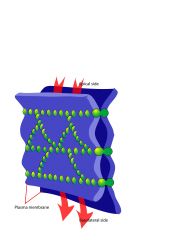
What type of cell junction is this? |
Tight junction |
|

What type of cell junction is this? |
desmosome
|
|
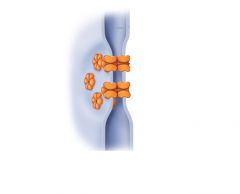
What type of cell junction is this? |
Gap junction |
|
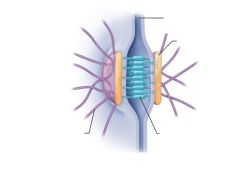
Label the parts of a Desmosome junction. |
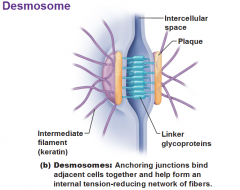
|
|
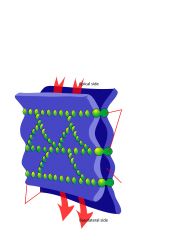
Label the parts of a Tight junction. |
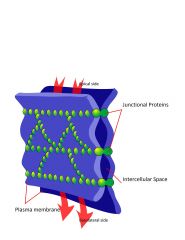
|
|
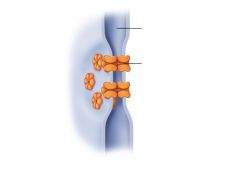
Labe the parts of a Gap junction. |
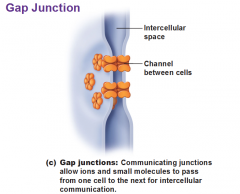
|
|
|
Cell Junction: Gap Junction (definition?) |
is a communication junction between adjacent cells. - are present in electrically excitable tissues like the heart. |
|
|
Interstial fluid (definition?) |
Extracellular fluid surrounding our cells. |
|
|
Selective or Differentially Permeable Membrane (definition?) |
Membrane allows some substances to pass while excluding others. |
|
|
2 ways substances move through the plasma membrane? |
Passive process
Active process |
|
|
Plasma membrane transport: Passive Process (definition?) |
Substances cross the membrane without any energy input from the cell. |
|
|
Plasma Membrane Transport: Active Process Cell membrane Transport or solute pump (definition?) |
Membrane transport processes for which ATP is required.
- requires carrier proteins that combine specifically and reversibly with the transported substances.
-moves solutes "uphill" against a concentration gradient. |
|
|
2 main types of Passive process cell membrane transport? |
Diffusion
Filtration |
|
|
Cell membrane transport: Diffusion (definition?) |
The tendency of molecules or ions to move from an area where they are in higher concentration to an area where they are in lower concentration. |
|
|
Cell membrane transport: what 2 major factors influences the speed of diffusion? |
Size
Temperature |
|
|
Cell membrane transport: what type of ions or molecules Will diffuse through the cell membrane? |
1) lipid soluble 2) small enough to pass through membrane channels 3) assisted by a carrier molecule |
|
|
Cell membrane transport: Simple Diffusion (definition?) |
Unassisted diffusion of lipid soluble or very small particles |
|
|
Cell membrane transport: Osmosis (definition?) |
Term given to the diffusion of a solvent (usually water) through a membrane. |
|
|
Cell membrane transport: Facilitated Diffusion (definition?) |
certain molecules and ions are not able to pass throught he lipid bilayer. These substances are either: 1) bound to portein carriers in the membrane and is ferried across or
2) moved through water filled protein channels. |
|
|
Carrier-mediated facilitated diffusion: Carriers (definition?) |
are trans-membrane integral proteins that are specific for transporting certain polar molecules of classes of molecules, such as sugars and amino acids, that are too big to pass through the membrane.
|
|
|
Carrier-mediated facilitated diffusion (definiton?) |
alterations in the shape of the carrier protein allow it to first envelop and then release the transported substance, shielding it en route from the non-polar regions of the membrane. |
|
|
Channel-mediated facilitated diffusion: Channels (definition?) |
trans-membrane proteins that transport substances, usually ions or water, through aqueous channels from one side of the membrane to the other.
channels are selective due to pore size and the charges of the amino acids lining the channel. |
|
|
Cell membrane transport: Leakage Channels |
are always open and simply allow ions or water to move according to concentration gradients. |
|
|
Cell membrane transport: Gated Channels |
are controlled (opened or closed) by chemical or electrical signals. |
|
|
Cell membrane transport: Aquaporins (AQPs) |
construct water specific channels that water can move freely and reversibly.
abundant in red blood cells and in cells involved in water balance such as kidney tubule cells. |
|
|
Cell membrane transport: Osmolarity (definition?) |
total concentration of all solute particles in a solution. |
|
|
Cell membrane transport: Tonicity (definition?) |
refers to the ability of a solution to change the shape or tone of cells by altering the cells' internal water volume. |
|
|
Cell membrane transport: Isotonic Solutions (definition?) |
solutions have the same concentrations of non-penetrating solutes as those found in cells.
-cells in isotonic solutions keep their normal shape, and exhibit no net loss or gain of water. |
|
|
Cell membrane transport: Hypertonic Solutions (definition?) |
solutions have higher concentration of non-penetrating solutes than seen inside the cell.
-cells immersed in hypertonic solutions lose water and shrink or crenate
|
|
|
Cell membrane transport: Crenate (definition?) |
Shrinking of red blood cells (only RCB) because they are immersed in a hypertonic solution. |
|
|
Cell membrane transport: Hypotonic solutions |
more dilute than the cells. There is more water outside the cell than inside.
- cells plump up quickly absorbing the water and swell or burst |
|
|
Cell membrane: Lyse (definition?) |
Cell burst or breakage |
|
|
What is the different energy sources for Primary active transport and secondary active transport? |
primary active transport - energy to do work comes directly from hydrolysis of ATP
secondary active transport - transport driven indirectly by energy stored in ionic gradients created by primary active transport pumps. Are all coupled systems meaning they move more than one substance at a time. |
|
|
Cell membrane Transport: Symport system (definition?) |
the two transported substances move int eh smae direction. Sym = same |
|
|
|
the transported substances "wave to each other" a the cross the membrane in opposite directions. Anti = opposite |
|
|
Cell membrane transport: Primary Active Transport (definition?) |
hydrolysis of ATP results in the phosphorylation (chemical reaction in which a phosphate molecule is added to a molecule) of the transport protein.
This step causes the protein to change its shape in such a manner that it "pumps" the bound solute across the membrane.
Ex. sodium-potassium pump. |
|
|
Cell membrane transport: Secondary Active Transport (definition?) |
a single ATP-powered pump, such as the sodium-potassium pump, can indirectly drive the secondary active transport of several other solutes.
-Ex. a sodium moves back into the cell with the help of a carrier protein, other substances are "dragged along" by the same carrier protein. |
|
|
Cell membrane transport: Vesicular Transport (definition?) |
transport using vesicles to move fluids containing large particles and macromolecules are transported across cellular membranes
-energized by ATP |
|
|
Cell membrane transport: Vesicles (definiton?) |
membranous sacs used in vesicular transport |
|
|
Cell Membrane transport: Endocytosis (definiton?) |
Vesicular transport moves substances into the cell |
|
|
Cell membrane transport: Exocytosis (definiton?) |
Vesicular transport moves substances out of the cell |
|
|
Cell membrane transport: Phagocytosis (definiton?) |
-"cell eating" -cell engulfs some relatively large or solid material, such as a clump of bacteria, cell debris, or inanimate particles. |
|
|
Cell membrane transport: Amoeboid Motion (definiton?) |
- changing shape -the flowing of their cytoplasm into temporary extensions allows them to creep along. |
|
|
Cell membrane transport: Pinocytosis or Fluidphase Endocytosis (definition?) |
Engulfing of extracellular fluid by cells. |
|
|
Cell membrane transport: Receptor-Mediated Endocytosis (definition?) |
the type of endocytosis in which engulfed particles attach to receptors before endocytosis occurs. |
|
|
Cell membrane transport: Caveolae (definiton?) |
-"little caves" Tublar or flask-shaped inpocketing of the plasma membrane seen in many cell types, are involved in a unique kind of receptor-mediated endocytosis. |
|
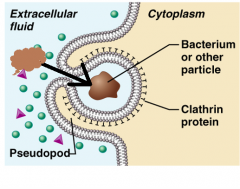
What type of endocytosis is this? |
Phagocytosis |
|
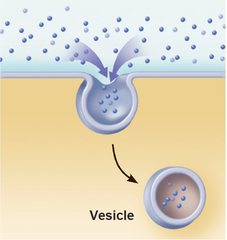
What type of endocytosis is this? |
Pinocytosis |
|
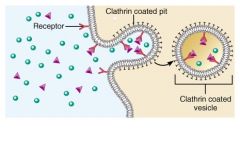
What type of endocytosis is this? |
Receptor-mediated endocytosis |
|
|
Cell membrane transport: Exocytosis (definition?) |
vesicular transport processes that eject substances from the cell interior into the extracellular fluid. |
|
|
Plasma Membrane: Membrane Potential (definition?) |
voltage across the plasma membrane. |
|
|
Plasma Membrane: resting membrane potential (definition?) |
-typically ranges from -50 to +100 mv (millivolts)
the voltage that exists across the plasma membrane during the resting state of an excitable cell |
|
|
Plasma membrane: Polarized (definiton?) |
state of a plasma membrane of an unstimulated neuron or muscle cell in which the inside of the cell is relatively negative in comparison to the outside
-minus sign before the voltage indicates that the inside of the cell is negative compared to the its outside |
|
|
Plasma membrane: cell adhesion molecules (CAMS) (definition?) |
- play key roles in embryonic development and wound repair (situations where cell mobility is important) and immunity.
|
|
|
Plasma membrane: Cell adhesion molecules act as: (name 5 roles) |
1) the molecular "velcro" that cells use to anchor themselves to molecules in the extracellular space and to each other (in desmosomes)
2) The "arms" that migrating cells use to haul themselves past one another.
3) SOS signals sticking out from the blood vessel lining that rally protective white blood cells to a nearby infected or injured area.
4) mechanical sensors that respond to changes in local tension or fluid movement at the cell surface by stimulating synthesis or degradation of adhesive membrane (tight) junctions.
5) Transmitters of intracellular signals that direct cell migration, proliferation and specialization |
|
|
Plasma Membrane: Membrane Receptors |
a huge and diverse group of integral proteins and glycoproteins that serve as binding sites |
|
|
Plasma Membrane: Contact signalling |
cells come together and touch, is the means by which cells recognize one another. |
|
|
Plasma Membrane: Ligands (definition?) |
chemicals that bind specifically to plasma membrane receptors.
-include most neurotransmitters, hormones, and paracrines (chemicals that act locally and are rapidly destroyed). |
|
|
Plasma Membrane: chemical signaling (definition)? |
using chemicals to signal plasma membrane |
|
|
Plasma membrane: electrical signaling (definition?) |
certain plasma membrane proteins are channel proteins that respond to changes in membrane potential by opening or closeing the channel. |
|
|
Plasma membrane: G Protein |
protein that relays signals between extracellular first messengers (hormones or neurotransmitters) adn intracellular second messengers (such as cyclic AMP) via an effector enzyme. |
|
|
Cytoplasm (definition?) |
-the cellular material between the plasma membrane and the nucleus, -is the site of most cellular activities. |
|
|
What 3 major elements make cytoplasm? |
1) cytosol 2) organelles 3) inclusions |
|
|
Cytoplasma: cytosol (definition?) |
viscous, semitransparent fluid in which the other cytoplasmic elements are suspended. |
|
|
Cytoplasma: Organelles (definition?) |
-"little organs" -metabolic machinery of the cell - each type of organelle carries out a specific function for the cell |
|
|
Cytoplasma: Inclusions (definition?) |
chemical substances that may or may not be present, depending on cell type.
-Ex. include stored nutrients, such as the glycogen granules in liver and muscle cells; lipid droplets in fat cells; pigment (melanin) granules in certain skin and hair cells; and crystals of various types. |
|
|
Organelles: Mitochondria (definition?) |
-threadlike or lozenge-shaped membranous organelles
-has two membranes: -outer membrane is smooth and featureless -inner membrane folds inward forming shelf-like cristae that protrude into the matrix, (gel- like substance within the mitochondria). -able to reproduce itself. -contains its own DNA, RNA, and ribosomes. |
|
|
Organelles: Cristae (definition?) |
-inner membrane folds of the mitochondria. |
|
|
What does the mitochondria do with energy? |
captures released energy and uses it to attach phosphate groups to ADP to form ATP. |
|
|
What type of process does the mitochondria use?
aerobic or anarobic |
aerobic |
|
|
Does mitochondria contain its own DNA, RNA and riosomes? |
yes |
|
|
What does the mitochondria do when cellular requirements for ATP increase? |
it synthesizes more cristae or simply pinch in half to increase their number then grow to their form size. |
|
|
Organelle: Ribosomes (definition?) |
-small dark-staining granules composed of proteins and a variety of RNAs called ribosomal RNAs. -each as two globular parts that fit together like an acorn and its cap. -sites of protein synthesis |
|
|
What are Free Ribosomes? |
ribosomes that are not attached to any membrane and float freely in the cytoplasm. |
|
|
What are Membrane-Bound Ribosomes? |
ribosomes that are attached to membranes forming rough endoplasmic reticulum. -sythesize proteins that are either incorporated into cell membranes or lysosomes; or for export from the cell. |
|
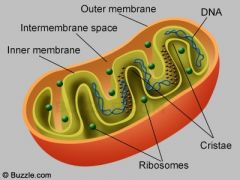
name the organelle. |
mitochondria |
|
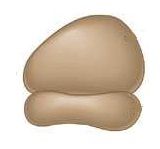
name the organelle. |
ribosomes |
|
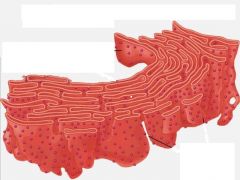
name the organelle. |
Rough endoplasmic reticulum |
|
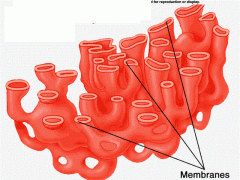
name the organelle. |
smooth endoplasmic reticulum |
|
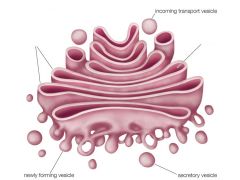
name the organelle. |
golgi apparatus |
|
|
name the organelle: Text book pg.94 |
peroxisomes |
|
|
name the organelle: Text book pg.95 |
lysosomes |
|
|
name the organelle: Text book pg.95 |
microtubules |
|
|
name the organelle: Text book pg.95 |
microfiliments |
|
|
name the organelle: Text book pg.95 |
intermediate filaments |
|
|
name the organelle: Text book pg.95 |
centroles |
|
|
name the organelle: Text book pg.95 |
cilia |
|
|
name the organelle: Text book pg.95 |
flagellum |
|
|
name the organelle: Text book pg.95 |
microvilli |
|
|
name the organelle: Text book pg.95 |
nucleus |
|
|
name the organelle: Text book pg.96 |
nuclear envelop |
|
|
name the organelle: Text book pg.96 |
nucleolus |
|
|
name the organelle: Text book pg.96 |
chromatin |
|
|
Organelle: Endoplasmic Reticulum (ER) |
-"network with in the cytoplasm" -an extensive system of interconnected tubes and parallel membranes enclosing fluid-filled cavities (cistern). - two different types of ER: rough and smooth |
|
|
What is Rough Endoplasmic Reticulum? |
-ER that has ribosomes attached at the outer surface. |
|
|
What do the ribosomes on Rough Endoplasmic Reticulum do? |
ribosomes bring proteins that thread their way into fluid-filled interior to the ER cisterns. when complete the newly made proteins are enclosed in vesicles and travel to the Golgi apparatus. |
|
|
What are the functions of Rough ER? |
-its ribosomes manufacture all proteins secreted from cells -the cells "membrane factory"; manufactures integral proteins and phospholipids that form part of all cellular membranes. |
|
|
Organelle: Smooth Enodplasmic Reticulum (definition?) |
-continuous with Rough ER -consists of tubules arranged in a looping network. -its enzymes are all integral proteins forming part of its membranes -its enzymes play no role in protein synthesis |
|
|
What tasks does the Smooth ER enzymes involved in? |
they catalyze reactions needed in:
-metabolizing lipids, synthesizing cholesterol and synthesizing the lipid components of lipoproteins (in liver cells).
-synthesizing steroid-based hormones such as sex hormones
-Detoxifying drugs, certain pesticides and cancer-causing chemicals in liver and kidneys
-breaking down stored glycogen to form free glucose.
-absorbing, synthesizing and transporting fats |
|
|
Organelle: Golgi Apparatus (definition?) |
-consists of stacked and flattened membranous sacs, shaped like hollow dinnerplates
-associated with swarms of tiny membranous vesicles |
|
|
What is the function of Golgi Apparatus? |
to modify, concentrate and package the proteins and lipids made at the Rough ER and headed out of the cell. |
|
|
Which is the Golgi Apparatus Cis Face side? |
The side that receives vesicles from the Rough ER |
|
|
Which is the Golgi Apparatus Trans Face side? |
The side that vesicles break off the Golgi Apparatus for export |
|
|
What are the 3 type of proteins that the Golgi Apparatus packages for export from the cell? |
1) proteins destined for export which migrate to the plasma membrane and discharge their contents from the cell by exocytosis. (secretory vesicles or granules)
2) lipids and trans-membrane proteins destined for the plasma membrane or for other membranous organelles.
3) digestive enzymes into membranous lysosomes that remain in the cell |
|
|
Organelle: Peroxisomes (definition?) |
-spherical membranous sacs containing a variety of powerful enzymes. Ex. oxidases and catalases |
|
|
What organelle contains Oxidase enzymes? |
Peroxisomes |
|
|
What does Oxidase do? |
uses molecular oxygen to detoxify harmful substances, including alcohol and formaldehyde |
|
|
What is the function of Peroxisomes? |
-neutralize free radicals (highly reactive chemicals with unpaired electrons that can scramble the structure of biological molecules.
-detoxify cells |
|
|
Where are high densities of Peroxisomes found? |
liver and kidneys |
|
|
Organelles: Lysosomes (definition?) |
-spherical membranous organelles containing activated digestive enzymes -provide sites where digestion can proceed safely within a cell. -digest cells |
|
|
What is Lysosomes functions? |
-digesting particles taken in by endocytosis, particularly ingested bacteria, viruses and toxins
-degrading worn-out or nonfunctinal organelles
-performing metabolic functions, such as glycogen breakdown and release
-breaking down non-useful tissues, such as the webs between the fingers and toes of a developing fetus and the uterine lining during menstruation.
-breaking down bone to release calcium ions into the blood |
|
|
Autolysis (definition?) |
When a cell ruptures and digests itself |
|
|
Organelle: Endomembrane System (definition?) |
a system of organelles that work together to:
-produce, degrade, store and export biological molecules
-degrade potentially harmful substances |
|
|
What organelles are included in the Endomembrane system? |
-ER -Golgi apparatus -secretory vesicles -lysosomes -nuclear membrane |
|
|
Cytoskeleton (definition?) |
- "cell skeleton" -network of rods running through cytosol adn accessory proteins that like these rods to other cell structures. - acts like anchors keeping structures where they should be. |
|
|
Name three type of rods in cytoskeleton |
- microfilaments -intermediate filaments -microtubules |
|
|
Organelle: Microfilaments (definition?) |
- thinnest elements of cytoskeleton - semiflexible strands of the protein Actin\ - each cell has its own unique network of microfilaments - but nearly all cells have dense cross-linked network of microfilaments called terminal web attached to the cytoplasmic side of the plasma membrane - involved in cell motility |
|
|
Organelles: Intermediate Filaments (definition?) |
- tough insoluble protein fibers that resemble woven ropes - made of twisted units of tetramer (=4) fibrils - most stable and permanent of the cytoskeleton elements - have high tensile strength - act as internal wires that resist pulling forces |
|
|
Organelles: Microtubules (definition?) |
- largest diameter of the elements of the cytoskeleton
-hollow tubes made of spherical protein subunits called tubulins
- most radiate from region near the nucleus (centrosome) -constantly growing out from the centrosome, disassembling and then reassembling at the same or different sites. -determine overall shape of the cell and distibution of cellular organelles - |
|
|
Organelles: Centrosome (definition?) |
- region near the nucleus - acts as a microtubule organizing center - contains paired centrioles - generates microtubules and organizing the mitotic spindle in cell division |
|
|
Organelles: Centrioles (definition?) |
- small, barrel-shaped organelles oriented at right angles to each other - consist of 9 triplets of microtubules - form the basis of cilia and flagellum |
|
|
Organelles: Cilia (definition?) |
- whip like motile cellular extensions - typically occur in large numbers - are on the exposed surfaces of certain cells - propel other substances - their action moves substances in one direction across cell surface. Ex. ciliated cells that line the respiratory tract move mucus laden with dust particles and bacteria upward away from the lungs. |
|
|
What makes up Cilia? |
- 9 + 2 doublet microtubules (a ring of 9 sets of 2 microtubules and 2 single microtubules in the center
- the basal body consists of 9 triplets of microtubules
-Plasma membrane coats the entire cilia |
|
|
Organelles: Flagella (definition?) |
- Long whip-like cellular extension containing microtubules (tail)
- formed by centrioles
-longer than cilia
- occurs singularly
-only flagellated cell in human body is sperm
- propels the cell itself |
|
|
Organelles: Microvili (definiton?) |
- "little shaggy hairs" - minute finger-like extensions of the plasma membrane - increase plasma membrane surface area tremendously and are most often found on the surface of absorptive cells |
|
|
Organelles: Nucleus (definition?) |
- the control center of the cell - contains genes - contains instructions to build almost all the body's proteins - signals the kinds and amounts of proteins to be synthesized at any one time in response to signals acting on the cell |
|
|
Multinucleate (definition?) |
cells that have many nuclei
- most cells only have on nucleus |
|
|
What type of cells are multinucleate? |
- skeletal muscle cells - bone destruction cells - some liver cells |
|
|
Anucleate (definition?) |
cells that do not have a nucleus -cells can not reproduce and only live for 3-4 months before they deteriorate. - cell can not produce mRNA to make proteins for cell repair |
|
|
What type of cell is anucleate? |
- blood cells |
|
|
What are the 3 recognizable regions or structures in the nucleus? |
1) nuclear envelope (membrane) 2) nucleoli 3) chromatin |
|
|
Organelle: Nuclear Envelope (definition?) |
- binds the nucleus - double membrane barrier that separated by a fluid-filled membrane - is selectively permeable |
|
|
What organelle is the outer nuclear envelope continuous with? |
Rough ER |
|
|
Organelles: Nucleoli (definition?) |
- spherical bodies inside the nucleus - where ribosomal subunits are assembled - not membrane bound - usually one or two nuclei per nucleus but can be more |
|
|
What region are nucleoli associated with? |
- nucleolar organizer regions, (contain the DNA that issue instructions for syntehsizing rRNA) |
|
|
Organelle: Chromatin (definition?) |
-system of bumpy threads weaving through the nucleoplasm |
|
|
What in chromatin composed of? |
- 30% DNA - 60% globular histone proteins that package and regulate the DNA - 10% RNA chains newly formed or forming |
|
|
Organelles: Nucleosomes (definition?) |
- fundamental units of chromatin - consist of flattened disc-shaped cores or clusters of 8 histone proteins connected like beads on a string by a DNA molecule. |
|
|
Organelles: Chromosomes (definition?) |
bar-like bodies of tightly coiled chromatin; visible during cell division. |
|
|
Cell Cycle: Cell Cycle (definition?) |
series of changes a cell goes through from the time it is formed until it reproduces. |
|
|
Cell cycle: What are 2 major periods of the cell cycle? |
- interphase - mitotic phase |
|
|
Cell cycle: Interphase (definition?) |
period of cell cycle where cell grows and performs usual activities |
|
|
Cell cycle: Mitotic phase (definition?) |
period of cell cycle where the cell divides into 2 cells |
|
|
Cell cycle: Interphase is divide into what 3 subphases? |
- "G = Gaps before and after S phase" - "S = synthetic" - G1 -S -G2 |
|
|
Cell cycle: What subphase is chromatin reproduced in? |
S subphase |
|
|
Cell cycle: G1 Phase "Gap 1 subphase" (definiton?) |
- cell is metabolically active - cell synthesizes rapidly - cell is growing - phase lasts: min - hrs in rapidly dividing cells days - yrs in slowly dividing cells - no activity directly related to cell division |
|
|
Cell cycle: S phase (definition?) |
- DNA is replicated - new histones are made and assembled chromatain - If replicated DNA is damaged, cell cycle ends until DNA repair mechanism fixes problem |
|
|
Cell cycle: G2 phase (definition?) |
- final subphase in interphase - synthesized and moved proteins to thier proper sites for cell division - prepares the cell to divide |
|
|
Cell cycle: Describe events of DNA replication. |
1. enzymes attach and separate DNA strands to form replication bubbles with parental DNA strand on each side.
2. DNA strands serve as templates for making complementary DNA from free DNA precursors - DNA synthesized by DNA polymerase enzymes
3. DNA polymerase links nucleotides along the template strand. DNA polymerase only works in one direction: Leading strand is synthesized continuously. Lagging strand is synthesized in segments in the opposite direction
4. Ligase enzymes splice the short segments of DNA together.
|
|
|
Cell cycle: What are the 2 events of Mitotic Phase? |
- mitosis - cytokinesis |
|
|
Cell cycle: Mitosis (definition?) |
-"thread process" - division of the nucleus |
|
|
Cell cycle: Cytokinesis (definition?) |
- "cell movement" - division of the cytoplasm |
|
|
Cell cycle: What are 4 phases of Mitosis? |
- prophase - metaphase - anaphase - telophase |
|
|
Cell cycle: When during Mitosis does cytokinesis begin? |
late anaphase |
|
|
Cell cycle: Cleavage Furrow (definition?) |
contractile ring made of actin filaments draws the plasma membrane inward to form cleavage furrow |
|
|
Cell cycle: What are 2 groups of proteins are needed for the cell to accomplish and enter mitosis? |
- Cyclins - Cdks (cyclin-dependent kinases) |
|
|
Protein synthesis: Gene (definition?) |
a segment of DNA molecule that carries instructions for creating one polypeptide chain |
|
|
Protein synthesis: What are the 4 nucleotide bases? |
- A (Adenine) - T (Thymine) - C (Cytosine) - G (Guanine) |
|
|
Protein synthesis: Triplet (gene definition?) |
- sequence of three nucleotide bases - are codes for specific amino acid |
|
|
Protein synthesis: Exons (definition?) |
amino acid-specifying informational sequences |
|
|
Protein synthesis: Interons (definition?) |
-separate exons - noncoding, repetitive segments |
|
|
Protein synthesis: Messenger RNA or mRNA (definition?) |
Long nucleotide strands that reflect the exact nucleotide sequences of the genetically active DNA and carry the DNA's message |
|
|
Protein synthesis: Ribosomal RNA or rRNA (definition?) |
forms ribosomes |
|
|
Protein synthesis: Transfer RNA or tRNA (definition?) |
small roughly L-shaped molecules that ferry amino acids to the ribosomes |
|
|
Protein synthesis: Transcription (definition?) |
transfers information from a DNA base sequence to the complementary base sequence of an mRNA molecule |
|
|
Protein synthesis: Promoter (definition?) |
special DNA sequence that contains the start point (beginning of the gene to be transcribed - specifies where mRNA synthesis stars and which DNA strand is going to serve as the templates strand |
|
|
Protein synthesis: RNA polymerase (definition?) |
enzyme that oversees the synthesis of mRNA correctly at the promoter |
|
|
Protein synthesis: Name the 3 basic phases of transcription? |
1) initiation 2) elongation 3) termination |
|
|
Protein synthesis: Initiation (definition?) |
RNA polymerase pulls apart the strands of the DNA double helix so transcription can begin at the start point in the promoter |
|
|
Protein synthesis: Elongation (definition?) |
RNA polymerase align RNA nucleotides with complementary DNA bases on the templates strand and then links them together. |
|
|
Protein synthesis: Termination (definition?) |
polymerase reaches a special base sequence called a termination signal, transcription ends and the newly formed mRNA separates from the DNA template |
|
|
Protein synthesis: Translation (definition?) |
translates language of Nucleic acids into language of proteins (aminio acids) |
|
|
Protein synthesis: Codon (definition?) |
three base sequence on a messenger RNA molecule that provides the genetic information used in protein synthesis; code for a given amino acid |
|
|
Protein synthesis: Anticodon (definition?) |
three base sequence complementary to the messenger RNA codon |

